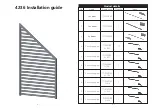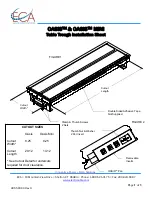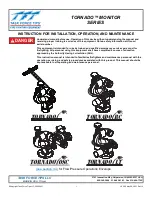
Assembling the Front Roller
1.
Press the first bearing into the roller housing
(
). Press on the outer race only or
equally on the inner and outer race.
2.
Insert the spacer (
3.
Press the second bearing into the roller housing
(
). Pressing equally on the inner and
outer race until the inner race comes in contact
with the spacer.
4.
Install the roller assembly into the cutting-unit
frame.
5.
Verify that there is no more than a 1.5 mm (0.060
inch) gap between roller assembly and the roller
mount brackets of the cutting-unit frame. If there
is a gap over 1.5 mm (0.060 inch), install enough
5/8-inch diameter washers to take up the slop.
Important:
Securing the roller assembly
with a gap larger than 1.5 mm (0.060 inch)
creates a side load on the bearing and can
lead to premature bearing failure
6.
Torque the mounting bolt to 108 N∙m (80 ft-lb).
Blade Maintenance
Blade Safety
A worn or damaged blade can break, and a piece
of the blade could be thrown at you or bystanders,
resulting in serious personal injury or death.
•
Inspect the blade periodically for wear or damage.
•
Use care when checking the blades. Wrap the
blades or wear gloves, and use caution when
servicing the blades. Only replace or sharpen the
blades; never straighten or weld them.
•
On multi-bladed machines, take care as rotating 1
blade can cause other blades to rotate.
Servicing the Blade Plane
The cutting unit comes from the factory preset at 5
cm (2 inches) height of cut and blade rake of 7.9 mm
(0.310 inch). The left and right heights are also preset
to within ± 0.7 mm (0.030 inch) of the other.
The cutting unit is designed to withstand blade
impacts without deformation of the chamber. If the
blade strikes a solid object, inspect the blade for
damage and the blade plane for accuracy.
Inspecting the Blade Plane
1.
Remove the hydraulic motor from the cutting unit
and remove the cutting unit from the machine.
2.
Use a hoist (or minimum of 2 people) and place
the cutting unit on a flat table.
3.
Mark 1 end of the blade with a paint pen or
marker. Use this end of the blade to check all
heights.
4.
Position the cutting edge of the marked end of
the blade at 12 o’clock (straight ahead in the
direction of mowing) (
) and measure
height from table to cutting edge of blade.
g011353
Figure 82
64









































